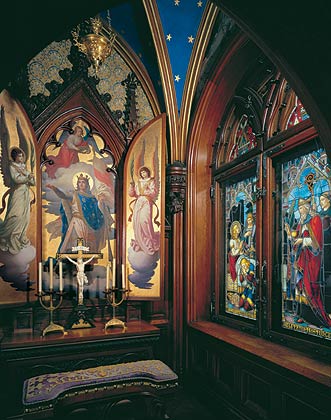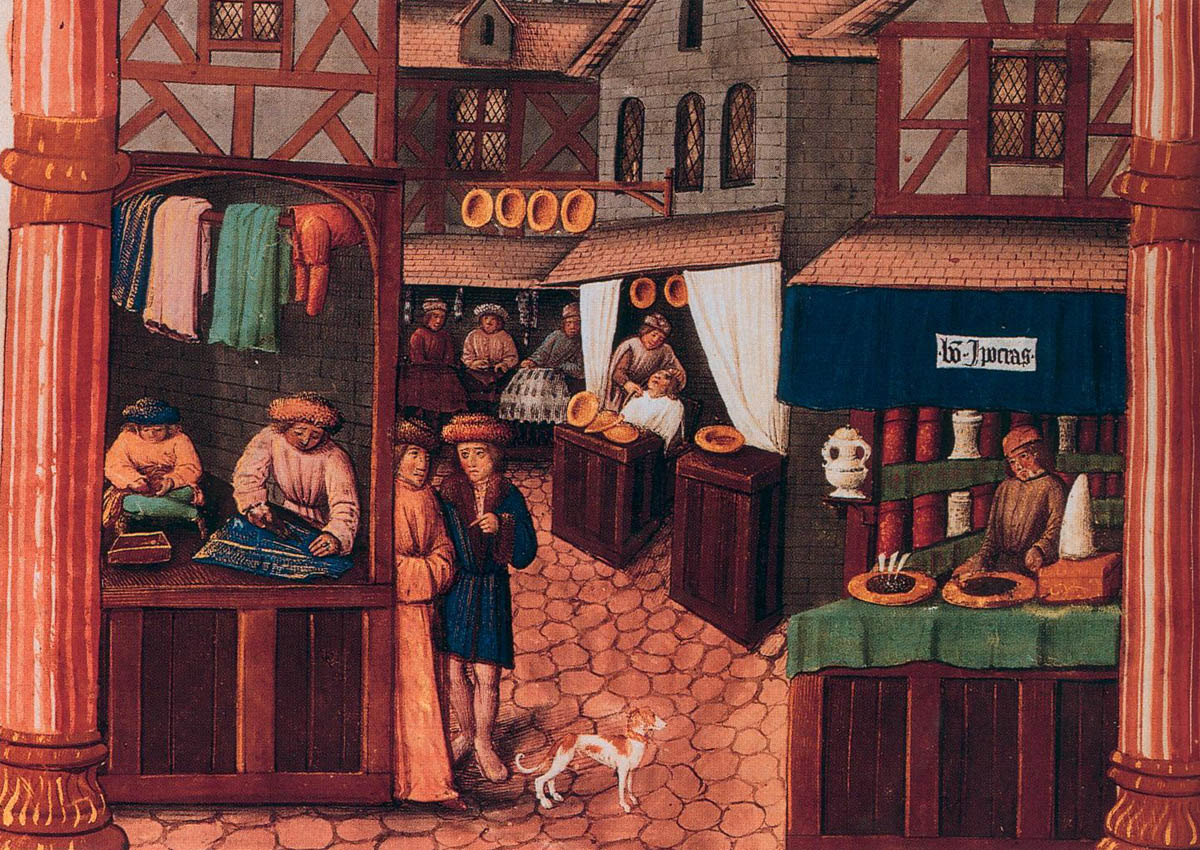Life in medieval England was varied but centred around commerce, crime, punishment, healthcare and living accommodations.
HOUSING
An Englishman's home is his castle and nothing indicated social class more than medieval housing. The Norman Conquest in the 11th Century led to castles being built throughout England and the original timber motte and bailey castles were soon replaced with imposing stone fortresses. Castle architecture in the 15th Century had developed into the Perpendicular Medieval Gothic style with fan vaulted ceilings, timber-trussed hammerbeam roofs and decorative designs carved with chisels.
 |
| A castle dissected and displaying it's various rooms |
The focal point inside a castle or manor house was the Great Hall where guests were wined and dined. Torches, candles and a fireplace illuminated the room with stone floors covered by carpet or mats. The walls of the Great Hall were decorated with gold paint, tapestries, shields, banners and paintings whilst wooden panelled wainscot lined the room walls. The castle air would be perfumed with sweet herbs such as lavender, camomile or rose petals to mask the pungent smells coming from the privy.
The Great Hall was furnished with a main table positioned on a dais that was surrounded with chairs painted with the heraldic designs often in red, green, white, yellow and black colours. Other guests sat on wooden benches around trestle tables which would allow a quick removal for after-meal entertainment or sleeping area for servants.
Lords and Ladies slept upstairs in the Great Chamber or Solar that was named after the sun shining through the south faced windows. The solar was also used as a private sitting room and was furnished with beds, chairs and chests. Personal servants also slept in the solar on a portable pallet for added protection.
 |
| A bower would provide privacy for a Lady |
The solar was connected to the bower room and was used by the Lady of the House and her ladies in waiting for embroidery, reading and music. The bower would be decorated with colourful tapestries, furs and pillows and the withdrawing room would later be renamed the drawing room. Clothes and jewels were kept in the wardrobe room that was connected to the solar and was an improvement from the original garderobe where clothes were kept in the latrine to deter moths.
Prayers were expected four times a day and would range between five and 30 minutes. Mass would be heard in the castle or house chapel and the small oratory room attached to the chapel would provide sanctuary for a private prayer. The oratory would be richly decorated with beautiful altar clothes and rich religious tapestries.
 |
| Medieval oratories would have been similar to this German one |
The castle was a symbol of power and had to be protected from enemies. Archers would be perched in the crenels on the battlements on top of the castle and would reload behind the stone merlons. The battlements also provided an ideal vantage point for defenders to view their oncoming enemy and the Duke of York likely weighed up his options looking down on to Wakefield Green from the battlements of Sandal Castle on the morning of 30 December 1460. York would later venture out on to the field in front of the castle and would meet his death there at the Battle of Wakefield.
Wakefield was one of many towns throughout England with towns and villages consisting of farmers and tradesman living in houses and barns sheds clustered around the centre of the village. Commoners lived in houses of one or two rooms that were covered with thatched roofs and built together with wooden frames filled in with wattle and daub that consisted of strips of wood woven together and covered in a 'plaster' of animal hair and clay.
 |
| A medieval townhouse |
More affluent towns had houses made of stone which were whitewashed or painted in bright colors with wooden shutters letting in the sunlight. An open fire was used for cooking and heating In the middle of the straw-covered earth floor and commoners sat around on benches or stools. Wooden table and chests stored clothes and other valuables while tools and utensils were kept on hooks. Rush lights dipped in animal fat illuminated the room animal fat.
Commoners were either free men or as "villeins" who bound to the land, working heavy labour for their lord and were subject to feudal dues. Village life was busy for both sexes and women would toil in the fields, wearing simple dress and living on a meager diet.
Outside influences would affect village life as trade began to spread as people began to be drawn to bigger towns and cities.
COMMERCE
The annexation of Flanders by the Burgundian empire allowed English traders to have easy access to exotic imports such as silks and spices. Merchants were soon protected by treaties and government troops whilst the workers banded together to form Guilds. A wide range of trades formed these guilds including bakers, butchers, grocers, millers, smiths, carpenters, weavers, masons and cobblers. Industry standards such as weights and measures were governed by the guilds and inspectors would visit shops to ensure compliance. The guilds would also assist members who were sick or in trouble and would often take care of families following a member's death.
 |
| A smith shows of his wares |
Traders would teach their knowledge and skills to apprentices would also act as their master's domestic servant and helper. Upon completion of the apprenticeship, the relevant guild would certify them as journeymen who would travel across towns to learn more about the trade.
 |
| Market stalls in the town square |
The market square would be at the centre of a medieval town and would hold markets at least once a week where local merchants would set up stall and sell their wares. Fairs were held several times a year and would attract foreign merchants into bringing fine wool, silks, spices, carpets and other items from far away lands. These fairs would last for days and would often attract performers such as strolling minstrels, performing tumblers, acrobats, and animal acts with trained bears and horses.
CRIME & PUNISHMENT
The growth in population led to an increase in crime and the evolution of English justice from the Magna Carta would see juries of 12 men or a justice of the peace pass judgement.
Gaols would generally be used to hold prisoners awaiting trial and Richard III's brief reign saw judicial reform that looked to protect the rights of the accused. Those who couldn't afford legal representation could have their cases heard by the Privy Council and the court would later be known as the Court of Requests. Bail legislation was also reformed to protect suspects from being imprisonment awaiting trial and asset seizure whilst ordering the translation of Laws and Statutes into English.
 |
| Petty crimes resulted in public shaming and humiliation |
The sentences handed out to convicts would often involve severe punishments that looked to deter others from doing the same. Petty crimes resulted in being placed in the stocks to be publicly humiliated and shamed, stealing food to survive was punished with a hand being chopped off. More serious crimes would lead to punishment by death with heresy punished by being burnt at the stake, murderers were hanged and traitors would be executed by being hung, drawn and quartered in public as a deterrent.
The barbaric punishment of being hung, drawn and quartered would see the condemned hanged until they were half dead, taken down, and quartered by having their limbs torn by horses pulling them apart. The convict was still alive when their genitals and bowels would be cut from their bodies and thrown into a fire until finally being killed by decapitation.
 |
| Traitors would often be displayed as a warning to others |
The body parts of traitors were often displayed as a warning to others like Jack Cade's torso being sent to the four corners of the rebel's home county of Kent and the decapitated heads of the Duke of York, Earl of Rutland and Earl of Salisbury were displayed on spikes atop of Micklegate Bar in York.
HEALTH
The Black Death had ravaged England in the 14th Century and fears of it returning were never far from the minds of those across all social classes. The wealthy would often live longer than the poor due to the unhygienic common living quarters of the commoners where a village or town street would be littered with human and animal waste. The town's sanitation would involve buckets of waste being thrown into the street whereas the wealthy were able to rid of their waste down the privy chute into a nearby moat or stream.
Monasteries had provided healthcare and lodging for the infirm for centuries but the lack of regular hospitals would lead to traders doubling up as doctors that included barbers as surgeons and gave rise to the village apothecary.
| Health was often governed by the stars |
The theory of the Four Humors from Greek doctor Galen was practiced over a millennium later and the unbalanced humors would be treated with blood letting either through piercing the skin or leeches. Religion, superstition and medical ignorance saw health governed by the stars and death or disease being reasoned by God's wrath in the form of omens. Such omens included the Solar Eclipse on the day of Queen Anne Neville's death or the rise of the sweating sickness after Henry Tudor had landed with French mercenaries in 1485 to claim the throne.

No comments:
Post a Comment